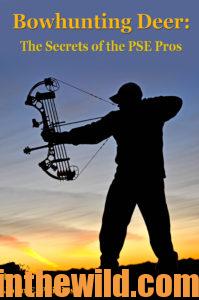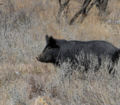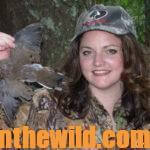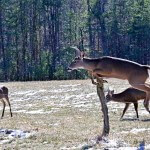Editor’s Note: No better sport exists for the bowhunter than hog hunting. You can hunt hogs throughout the South and in parts of the West at any time during the year, and you can bag as many hogs as you want, due to the destruction feral pigs cause to crops, their contamination of water supplies and their preying on ground nesting birds’ eggs, turkey poults, turkey hens sitting on their nests and just-born fawns. By using feeders and cameras, you can pinpoint where the hogs are moving and use the feeders to bait them, as most states allow you to bait hogs (check your local regulations). Whether you’re hunting in the thick palmettos of Florida, the oak brush of Texas and/or the briarpatches of Mississippi, you can pull ravenous wild porkers out of thick cover by baiting your feeder with corn.
 * Scout for hogs the day before you plan to hunt, since hogs may stay in an area one day and leave there the next day.
* Scout for hogs the day before you plan to hunt, since hogs may stay in an area one day and leave there the next day.
* Remember that hogs will go most anywhere but generally prefer to bed and travel close to water and in thick cover.
* Do your homework. If you find a tree that hogs have rubbed against, or boars have sharpened their tusks on, the higher you see the tusk slashes from the ground, generally the bigger the boar. Although this sign means a big boar has frequented this region, don’t put a tree stand there. You’re more likely to catch hogs moving on trails leading from feeding to bedding areas.
* Keep trees and brush between you and the hog to break-up your silhouette, if you’re trying to stalk to within bow range.
 * Make sure you’re always downwind of a feral pig, which has a very-keen sense of smell. Never walk across the trail you expect hogs to come from to reach your tree stand when you use a tree stand. Even when wearing rubber boots, you can leave enough human odor in the area to spook a wild hog.
* Make sure you’re always downwind of a feral pig, which has a very-keen sense of smell. Never walk across the trail you expect hogs to come from to reach your tree stand when you use a tree stand. Even when wearing rubber boots, you can leave enough human odor in the area to spook a wild hog.
* Plan to change stands if you shoot at or miss a hog on one stand because more than likely that same hog or group of hogs won’t return to that stand site anytime soon.
* Place your arrow behind the gristled shield on the hog’s shoulders that covers the hog’s vitals for your best chance to recover a hog once you’ve hit it. Take a quartering-away shot as your best opportunity to bag that wild hog.
* Take a dog with a good nose into the area where you’ve arrowed a hog. Due to the fat in a big hog, its wounds will close-up quickly and won’t leave a good blood trail. However, a dog with a good nose that’s accustomed to locating wounded game often will find your hog for you.
* Hunt the trails leading to a feeder, not right over the feeder, to see wild hogs the most consistently. If you take or wound a hog on the trail leading to the feeder, the hogs will continue to use that feeder but may take a different trail to it. However, if you shoot at, hit or miss a hog at a feeder, the hogs may not return to the feeder for several days.
 * Identify the two types of hogs, offensive hogs and defensive hogs. An offensive hog, a boar, will weigh 200 pounds or more and has large tusks. You’ll seldom spot a wild hog like this. If you do take him, you probably won’t enjoy the strong-tasting meat, unless the landowner has castrated and released the boar earlier. A defensive hog, either a sow or a boar, will weigh between 50 and 150 pounds, a size of feral hog you’ll see often while hunting. You’ll find a defensive hog easier to take, delicious to eat, low in cholesterol, since it won’t have much fat and is usually tender. Many bowhunters when hunting feral hogs enjoy taking defensive hogs first for food. Then they’ll hunt for trophy tuskers.
* Identify the two types of hogs, offensive hogs and defensive hogs. An offensive hog, a boar, will weigh 200 pounds or more and has large tusks. You’ll seldom spot a wild hog like this. If you do take him, you probably won’t enjoy the strong-tasting meat, unless the landowner has castrated and released the boar earlier. A defensive hog, either a sow or a boar, will weigh between 50 and 150 pounds, a size of feral hog you’ll see often while hunting. You’ll find a defensive hog easier to take, delicious to eat, low in cholesterol, since it won’t have much fat and is usually tender. Many bowhunters when hunting feral hogs enjoy taking defensive hogs first for food. Then they’ll hunt for trophy tuskers.
 To learn more about bowhunting, check out John E. Phillips’ eBook, “Bowhunting Deer: The Secrets of the PSE Pros” at http://amzn.to/VBr1qW. You also can download a free Kindle app that enables you to read the book on your iPad, computer or SmartPhone.
To learn more about bowhunting, check out John E. Phillips’ eBook, “Bowhunting Deer: The Secrets of the PSE Pros” at http://amzn.to/VBr1qW. You also can download a free Kindle app that enables you to read the book on your iPad, computer or SmartPhone.
Tomorrow: What Biologists Have Learned about Feral Hogs










